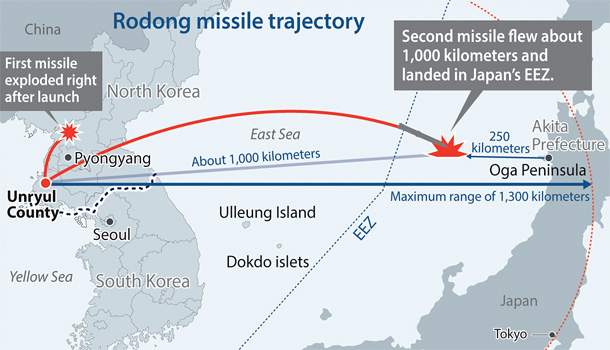North Korea shoots missile toward Japan

At around 7:50 a.m., Pyongyang launched the missile from Unryul County in southwestern South Hwanghae Province toward its eastern coast, said the South Korean Joint Chiefs of Staff (JCS).
It was presumed to be an intermediate-range Rodong missile, which has a range of up to 1,300 kilometers.
The North American Aerospace Defense Command (Norad) determined that Pyongyang actually fired two intermediate-range missiles, but one exploded in midair immediately after launch.
The U.S. Strategic Command said in a statement that it detected “the simultaneous launch of two presumed intermediate-range ballistic missiles,” adding that one “exploded immediately after launch, while the second was tracked over North Korea and into the Sea of Japan,” which South Korea calls the East Sea.
“The missile that North Korea launched toward its east coast today flew over 1,000 kilometers and landed in Japan’s air defense identification zone (ADIZ),” a JCS official said. Japan’s exclusive economic zone covers most of its ADIZ.
“Based on an analysis of its trajectory, speed and range,” the official continued, “it is presumed to be a Rodong missile.”
The military is not excluding the possibility that it might have been a Scud-type missile, particularly the more advanced, extended-range Scud-ER, also known as the Hwasong-7, which can travel more than 1,000 kilometers, long enough to cover the entire Korean Peninsula and reach U.S. military installations in Japan.
Wednesday’s launches were the 13th round of missile tests by North Korea this year, or 29 launches in total.
Pyongyang launched two Rodong missiles on March 18 and two Rodong missiles and a shorter-range Scud-type missile on July 19. All ballistic missile launches violate United Nations Security Council resolutions.
Wednesday’s tests follow Seoul and Washington’s decision to deploy the American Terminal High Altitude Area Defense (Thaad) antiballistic missile system in South Korea to counter Pyongyang’s rising military threat, especially following its fourth nuclear test in January.
The JCS condemned the latest ballistic missile launches, calling them an indication of Pyongyang’s ambition to “directly and broadly attack neighboring countries,” and South Korea’s ports, airfields and other locations.
This comes ahead of the annual joint military drill between Seoul and Washington, the Ulchi Freedom Guardian exercise, later this month, which Pyongyang has responded sensitively to in the past.
In an annual defense white paper released Tuesday, Japan was critical of Pyongyang’s nuclear and missile program and also renewed territorial claims over Korea’s easternmost Dokdo islets in the East Sea, which could have been another motivation for Pyongyang in shooting the missile in its direction.
The Japanese Defense Ministry said this was the first time a North Korean missile landed in its EEZ since 1998.
Japanese Prime Minister Shinzo Abe immediately called the missile launch an “unforgivable act of violence toward Japan’s security” and convened a National Security Council meeting.
“Through the launch [Pyongyang] is trying to show off its striking ability,” said Jeong Joon-hee, spokesman of the South Korean Ministry of Unification. He demanded North Korea “immediately halt” such acts, which he added are “a serious provocation against the Korean Peninsula and the international community.”
BY SARAH KIM [kim.sarah@joongang.co.kr]










with the Korea JoongAng Daily
To write comments, please log in to one of the accounts.
Standards Board Policy (0/250자)